Department proposal would hike a 500k annual program to $3 Million
By Robert Lynch; May 28, 2025
Improving local emergency medical services and speeding ambulance response times, particularly to patients in Tompkins County’s rural areas, has suddenly gotten a lot more complicated.
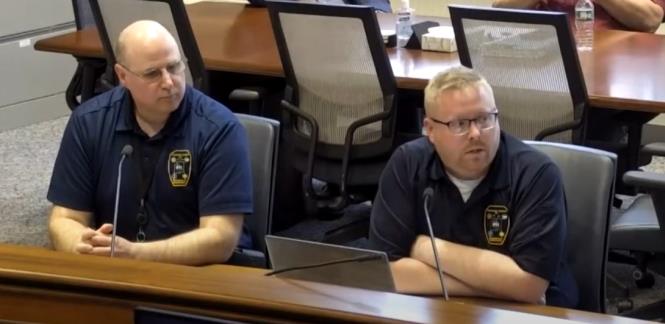
Two supposedly complimentary—though potentially conflicting—proposals that would increasingly involve Tompkins County Government in the emergency treatment and transport business got their first, individual airings May 27 before the Tompkins County Legislature’s Public Safety Committee. But after the committee’s 90-minute discussion Tuesday had ended, no clear plan emerged as to in which way emergency medical services (EMS) will actually go.
“We’ve kind of been proceeding on parallel tracks,” committee Chair Rich John observed of those choices even before staff from Tompkins County’s Department of Emergency Response (“DOER”) and Paul Bishop, Project Director of the consulting firm Center for Governmental Research (“CGR”), had taken their respective turns before the committee.
CGR asked only for money and a contract. Bishop requested County Government spend $48,000 for his Rochester-based firm to study EMS’s problems. Under his proposal, CGR would make recommendations and then outline available options to the County Legislature by September 30.
DOER’s proposal is far more concrete—not to mention ambitious. And its concept has already ruffled a few feathers along the way. DOER would expand the already existing, but now operationally modest, County-run Rapid Medical Response (RMR) service to become a backup ambulance operation of sorts.
Under DOER’s self-proclaimed “EMS Strategic Vision,” RMR’s annual spending would skyrocket five-fold.
DOER’s “Strategic Vision” would have Tompkins County buy three ambulances, increase RMR’s full- and part-time medical staff from its current six people to as many as 30 (plus Per Diem help), and grow a $546,828 budget to just over $3 Million.
“We came up with this program to help augment our current transport agencies and not replace them, Joe Milliman, Tompkins County’s EMS Program Manager, informed the committee. He joined Director of Emergency Response Michael Stitley for the May 27 presentation.
But the Rapid Medical Response program Milliman and Stitley envision to fill perceived needs and to serve its limited purpose is a far cry from how the program began and what it remains at present.
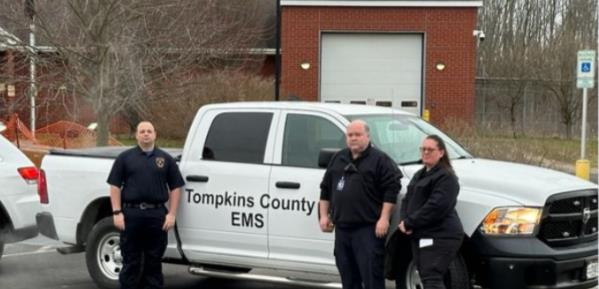
Aside from the multiples of increased cost, RMR would expand from only EMT-level “Basic Life Support” (BLS) to also include “Advanced Life Support,” (ALS), higher-level care that Stitley says requires a trained paramedic to deliver. Under the “Vision,” one ambulance would run 24/7, the second, daytimes-only. The existing service currently runs from only 7 AM to 7 PM, weekdays.
RMR was conceived and launched in April of last year after officials sensed a shortage of volunteers, a shortage that had depleted the ranks of local fire department rescue squads, particularly during daytimes. RMR presently employs Emergency Medical Technicians (EMT’s) only. It stations them one to a car, and utilizes pickup trucks and SUV’s repurposed from the County Government’s motor pool.
The current RMR service has no ambulance. Any new units purchased would provide only basic life support. DOER budgets them at $150,000 apiece.
Nowhere in its written proposal does DOER specify a start-up date. Nor was it stated at the meeting. But one infers that the transformation could take place as soon as 2026. After the committee adjourned, Director Stitley acknowledged that the service could begin as soon as next year; if not that soon, then in 2027.
The Public Safety Committee took no vote on any of the Emergency Medical Response choices Tuesday, leaving matters very much up in the air. Instead, Rich John signaled that he’ll offer a so-called “Member-filed Resolution” for the full Legislature to consider, probably in June. The member initiative would authorize some revised version of the Center for Governmental Research’s initial proposal.
We will “refine the scope,” John said of the study after the meeting had adjourned. John suggested the consultant’s fee would likely fall below the $48,000 Bishop had quoted. The chairman also assured that the study will include DOER’s expansive model among its considered options.
The Department of Emergency Response’s heretofore undisclosed proposal emerged almost from nowhere. Its first disclosure came in an attachment to the committee’s online agenda packet, posted on Tompkins County’s meeting portal a few days before the meeting. Quite likely, some in government didn’t want details publicized ahead of time.
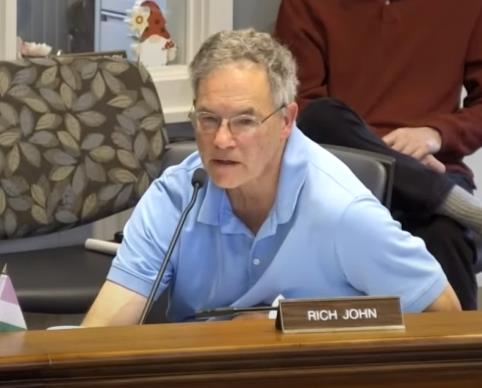
And that reticence could be for good reason.
As Milliman outlined his department’s initiative, several officers of the privately-owned and Ithaca-based Bangs Ambulance, Tompkins County’s largest transport agency, sat in the gallery. Invited by Rich John after the presentation to come forth and speak, company president Tim Bangs and Board of Directors member Brian August took polite, though direct hits at the DOER proposal. They viewed DOER’S plan as being too costly to the taxpayer and too demoralizing to the volunteer rescue squads that have partnered with Bangs for decades to save lives.
Regarding the money, Tim Bangs asked, “For the 80 years that Bangs Ambulance has been providing that service to Ithaca and Tompkins County, what has Tompkins County paid for that? Nothing.”
“It’s hard for a private service to compete against a public entity,” Brian August stated. He reminded all that public employees receive lucrative public benefits. August feared that if RMR were expanded, some Bangs’ staff would quit or downsize to part-time so as to join Tompkins County’s workforce and then reap the benefits.
Tim Bangs advised the committee that when the RMR service launched last year, “the generic staffing level” amounted to “robbing Peter to pay Paul.” One employer’s gain was another one’s loss given the short supply of EMT’s and paramedics both in Tompkins County and across New York State.
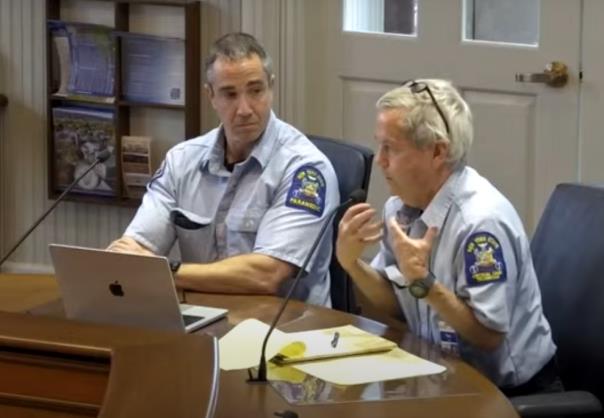
And a critical read of the staffing plan to implement the “EMS Strategic Vision,” suggests that Milliman and Stitley have employed a healthy amount of wishful thinking.
“The biggest question that we get is where are we going to get the staff,” Milliman acknowledged to the committee.
“Tapping into the local colleges,” the EMS program manager mentioned as one idea. Continuing to work with Tompkins Cortland Community College and Syracuse’s Upstate Medical Center to bring EMS training courses to Tompkins County was another the plan tossed out.
But the major expansion DOER envisions requires not just lower-level EMT’s, but also higher-skilled paramedics. Tim Bangs claimed that the nearest paramedic training schools require travel to Elmira, Syracuse, or Binghamton.
And then there’s the issue of volunteer morale; the attitudinal adjustment that comes when a firehouse volunteer learns that what he’s doing for free has become a task somebody else is doing for pay.
Tim Bangs said he’d heard the complaints when the RMR program began. Volunteers would say, “If this call comes out… and I know that the County is getting paid to go to that call, I’m going to sit in the station, and I’m not going to go because I’m not getting paid for it. I’m a volunteer. If they’re going to get paid, let them go on the call.”
Tim Bangs’ advice to the committee: “We would love to see instead of slamming the door on these first response agencies, let’s try to rebuild them.”
Yet “doing nothing is not an option,” Dryden Councilperson Dan Lamb stressed when Rich John invited outside comment. Lamb is among the select few who sit on the Emergency Planning and Preparedness Subcommittee of the Tompkins County Council of Governments (TCCOG). It was the subcommittee that in separate meetings first tapped Paul Bishop’s advice for EMS restructuring ideas, and then at a second session, heard DOER’s proposal.
This writer, Enfield’s TCCOG representative, attended the early-April session with Bishop, but was then requested by the subcommittee’s chair, Caroline Supervisor Mark Witmer, not to divulge its substance; only to recite a generalized statement Witmer had dictated. The later meeting with DOER was even more shrouded. Not even the full TCCOG membership was made aware of it when TCCOG convened May 22.
Witmer Tuesday defended his decision to keep subcommittee sessions private, arguing that the subcommittee is only a “working group,” exempt from the Open Meetings Law.
But more important than staffing, the key component to EMS’s reimagining is its cost. How will the bills get paid? If the Rapid Medical Response service’s budget is to balloon from a half-Million dollars to nearly six times that amount, who will pay the difference?
“New York State is not coming to save us,” Dan Lamb, a leader well-connected to Albany power-politics, cautioned the committee. “We’ve got to fix this on our own.” Yet how?
When funding for the current, more modestly-priced RMR program was first discussed, several cost-sharing ideas came forth. Back then, talk was that Tompkins County would pay a portion, maybe half, of the expense; local municipalities would fund the remainder. Under one option, the Town of Enfield’s share would exceed $58,000. That request later fell to $10,000, and still later dropped to zero, but only after a one-time state grant came through to underwrite the expense for 2025.
No similar lifeline will likely come for the year ahead, Director Stitley predicted after the meeting. Meanwhile, County Administrator Korsah Akumfi implied during the session that municipal cost-sharing remains very much on the table.
“It’s not worth paying for a service or a study (like, for example, Paul Bishop’s consultancy) if there’s no commitment to implement,” Akumfi said. “So we need to have that commitment from all the municipalities that we will buy into the idea so that it can be successful. Without that commitment, it will not be successful,” the Administrator reasoned.
There’s an elusive, yet pervasive unease one gets from examining DOER’s suddenly-surfaced prescription to Tompkins County’s EMS crisis, if indeed a crisis truly exists. One perceives a proposal slapped together too fast and founded on too many impulsive assumptions. And one discerns a plan that grants all-too fleeting consideration to the all-important bottom line: the money.
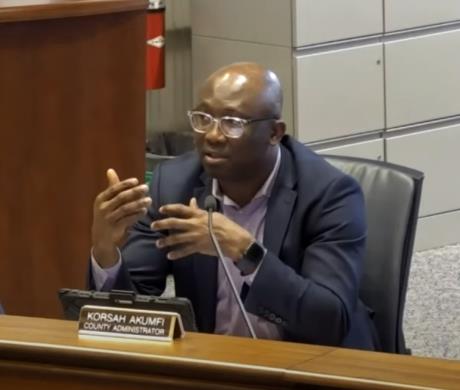
Public Safety Committee members grasped that unease Tuesday. And the deeper one digs into the Milliman-Stitley vision statement, the more essential Paul Bishop’s more detached perspective may prove advisable. An experienced consultant may find holes in the plan ready to poke.
Example: DOER wants Tompkins County to buy three ambulances. Paul Bishop’s reality check: “If you were to order an ambulance today… you wouldn’t see it for two, two-and-a-half years, if you wanted a new one.”
Or staffing: “It’s harder to find EMT’s and paramedics than it was even three or four years ago,” Bishop provided.
Sometimes, third-party expertise is worth what you pay for it. Chairman Rich John and the Public Safety Committee seemed to grasp that concept Tuesday.
Nevertheless, the Department of Emergency Response’s “EMS Strategic Vision” has its well-placed cheerleaders. They include Dryden’s Dan Lamb and Trumansburg Mayor Rordan Hart. Both leaders have professionally-paid municipal ambulance services within their towns, and both sit with Caroline’s Witmer on the TCCOG Emergency Preparedness Subcommittee.
“From the standpoint of the Village of Trumansburg, we strongly, strongly support the notion of the expansion of the RMR program,” Hart emphasized to the Public Safety Committee. “For me, this is really a public policy question, not an EMS or EMT operational or a structural question,” Hart stated.
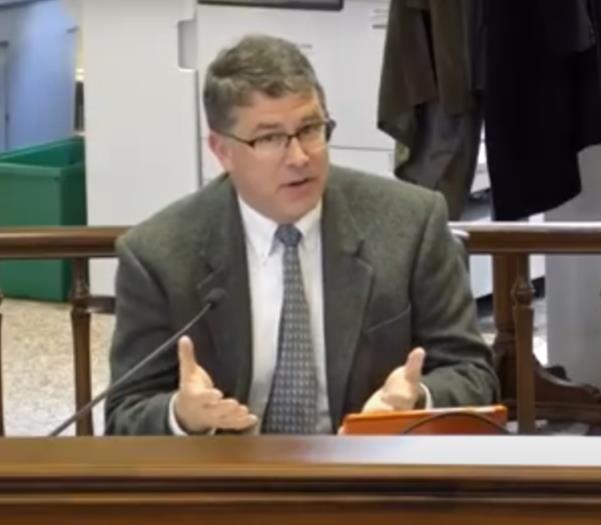
Mayor Hart would have Tompkins County treat EMS like it does law enforcement, consider it a department like that of the Sheriff, and budget the service accordingly.
As many of 26 percent of Trumansburg Ambulance’s calls go to places outside of T-Burg’s service area. Many gap-fill for Bangs. And many calls lose money. That out-of-area rate stands as high as 40 percent in Dryden.
“The thing that we can’t do is wait another year on this,” Dryden’s Lamb told the committee, “because my taxpayers are kicking in about a half-million dollars a year going outside of my town, and that’s a really hard thing for me to justify to the people that I serve.”
That said, equally hard to justify for anyone in Enfield government would be appropriating some large annual sum—maybe in the six-figures—as the local “cost-share” for a County-run, stand-by service that some may say duplicates work of the already well-equipped Enfield Volunteer Fire Company’s Rescue Squad.
But for those who might think that way—perhaps including Tim Bangs—Mayor Hart counters they’re living in the past.
“There isn’t in my opinion a way to make Tompkins County 1985 again, for lack of a better phrase,” Hart told the committee, “and resurrect a volunteer first response situation that simply doesn’t exist anymore.”
Then again, if Mayor Hart stands correct, where does all that new money come from; three million dollars of new money? No one’s offered that answer yet.
###

